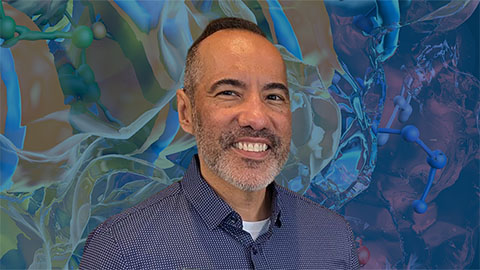Q&A with Jared Rutter
Jared Rutter at the University of Utah got hooked on cell metabolism early in his career. His laboratory focuses on understanding the dynamic nature of cell metabolism. As Rutter points out, cell metabolism typically is viewed as a passive process. But as his laboratory and others are finding out, there is more to it than simply churning out molecules of ATP.
 Rutter
Rutter
Earlier this year, Rutter was selected by the Howard Hughes Medical Institute to be one of its newest investigators. He was also one of the 10 finalists in the life sciences category this year for the Blavatnik Awards for Young Scientists. In addition, he is a member of the American Society for Biochemistry and Molecular Biology Council.
I know your lab works on cellular metabolic homeostasis. Can you tell me in a little more detail about the ongoing projects?
The overarching question that my lab tries to address is how do cells adapt their metabolism to be optimally suited for the behaviors that they are engaged in. A complementary part of that is when cells are forced to change their metabolism through mutations or through a change in the environment, how does that cause them to change their behavior or fate? Those are the two interlinked questions on which my lab is focusing.
We have a number of different projects focused on understanding basic mitochondrial functions and how that relates to cellular decisions. One project is aimed at understanding how changing mitochondrial oxidative metabolism influences cancer cells and stem cells.
We have a couple of other projects that are focused around mitochondrial quality control. What happens when mitochondria become aberrant or damaged? How does a cell respond to that to repair the damage or adapt to it?
Another segment of the lab is working on kinase signaling. A specific kinase we’ve worked on for some time called PASK integrates metabolic information and signals to control the behavior of cells in different ways, including how cells use their available energy.
How did you develop an interest in metabolism?
It came pretty early on in my scientific career. I’ve become convinced that the metabolic situation of the cell is a really important environmental factor that, until recently, was largely overlooked as anything other than just providing ATP and enabling the cell to go about and do its job. I have become convinced that metabolism is much more active in determining what the cell does rather than just doing what it’s told.
 Rutter on the green.PHOTO COURTESY OF JARED RUTTER
Rutter on the green.PHOTO COURTESY OF JARED RUTTER
Who drew you into science?
I have an uncle who is a prominent scientist. (Author’s note: Rutter’s uncle is William Rutter, formerly at the University of California, San Francisco, and now at Synergenics.) His influence encouraged me to think about science. I fell in love with it when I started taking the classes and doing a little bit of research as an undergraduate.
I went to (the University of Texas-Southwestern at Dallas) as a graduate student. I had a really great experience there. It encouraged me to pursue a research career in academia. I stayed and did a postdoc for about a year and a half. Then I took a job in Utah, and I’ve been here ever since. (Author’s note: After completing his Ph.D. with Steve McKnight at UT-Southwestern, the ASBMB’s current president, Rutter continued his training there through the Sara and Frank McKnight Fellowship.)
What are some of the big questions in your own field?
One of the biggest challenges in our field is the metabolic heterogeneity of cells. When we grind up a liver, for example, and measure some parameters, we make an implicit assumption that we’re measuring 10 million cells that are roughly the same. In reality, the 10 million cells are different, and our measurements typically average over those 10 million cells. The result is we get a pretty low-resolution view of whatever parameter we’re studying.
One of the areas that I think is very interesting is to study metabolism at a single-cell level and get at the metabolic heterogeneity of a population of cells, whether it’s in a tissue, a tumor or a dish. These cells aren’t acting in isolation but are actually communicating metabolically. For example, there are a number of situations where cell A will take in glucose and make lactate and cell B will take up the lactate and oxidize it to make CO2. There are several similar situations, and it is critical for us to understand them.
Are there any tools that let you piece this together at the single-cell level?
Not in a simple way. That’s something that my lab is hoping to do in the future. There are tools for studying individual cells, but they rarely have been applied to the study of metabolism.
What are your hobbies?
I have four children. My wife and I spend most of our time managing them when I’m not in the lab! I like to play golf. Outside of my family and my work, that’s probably the hobby that I enjoy the most. I try to do that whenever I can, especially when I travel. I plan to play golf in San Diego when I’m there for the ASBMB annual meeting! Also, I like to ski. I live in Utah, which is a great place for skiing and other outdoor activities like biking and hiking, which I also enjoy.
What words of advice would you give to scientists in training?
A phrase I heard recently was “the deletion test.” When we evaluate our contributions to science, we should think about the deletion test: If we weren’t there, would the progress of the scientific community be any different? I think the best way to pass the deletion test is to be working in areas and using technologies that other people aren’t. That way, we’re breaking new ground.
Enjoy reading ASBMB Today?
Become a member to receive the print edition four times a year and the digital edition monthly.
Learn moreGet the latest from ASBMB Today
Enter your email address, and we’ll send you a weekly email with recent articles, interviews and more.
Latest in People
People highlights or most popular articles

Meet the editor-in-chief of ASBMB’s new journal, IBMB
Benjamin Garcia will head ASBMB’s new journal, Insights in Biochemistry and Molecular Biology, which will launch in early 2026.

Exploring the link between lipids and longevity
Meng Wang will present her work on metabolism and aging at the ASBMB Annual Meeting, March 7-10, just outside of Washington, D.C.

Defining a ‘crucial gatekeeper’ of lipid metabolism
George Carman receives the Herbert Tabor Research Award at the ASBMB Annual Meeting, March 7–10, just outside of Washington, D.C.

Nuñez receives Vallee Scholar Award
He will receive $400,000 to support his research.

Mydy named Purdue assistant professor
Her lab will focus on protein structure and function, enzyme mechanisms and plant natural product biosynthesis, working to characterize and engineer plant natural products for therapeutic and agricultural applications.

In memoriam: Michael J. Chamberlin
He discovered RNA polymerase and was an ASBMB member for nearly 60 years.

